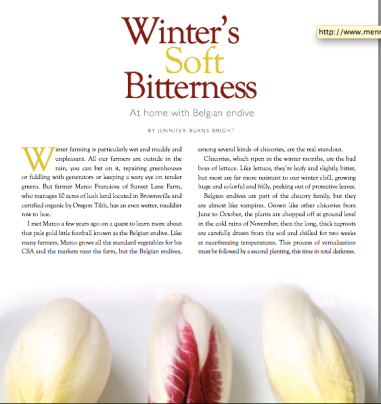This is the post for 2013. For 2014, click here. Have you seen the new Eugene Magazine food issue? Rush out and get it now for great profiles on some of our best restaurants, old and new, and ideas about holiday gifts for locavores. My contribution, the regular column Eat Drink Think, focuses on a local farm, Sunset Lane, that is one of the only commercial producers in the U. S. of that singular winter vegetable, Belgian endive. I included an updated recipe for braised endive nestled under a blue-cheesy, candied walnut and pear topping. Perfect for Christmas.
Have you seen the new Eugene Magazine food issue? Rush out and get it now for great profiles on some of our best restaurants, old and new, and ideas about holiday gifts for locavores. My contribution, the regular column Eat Drink Think, focuses on a local farm, Sunset Lane, that is one of the only commercial producers in the U. S. of that singular winter vegetable, Belgian endive. I included an updated recipe for braised endive nestled under a blue-cheesy, candied walnut and pear topping. Perfect for Christmas.
But if you don’t want to cook, you can really help our local economy. The Great Winter Freeze 2013 affected local businesses deeply, so any support we can give to our restaurants in December would be deeply appreciated.
So…here’s my annual roundup of restaurants open on those celebratory days of December! This year, Eugene Cascades and Coast has gathered a list of some eateries open Christmas and Eve 2013, so go ahead and click ze link for many details. In addition:
Christmas dinners: Sweetwaters on the River, Shari’s (multiple locations) and Sixth Street Grill, are all open, as listed in the link. Izakaya Meiji, not mentioned on the list, is also open on Christmas Eve and Christmas. Taste of India is open, with specials of saag paneer and lamb vindaloo. Sizzle Pie is open, and there’s a buy-one-large-get-one-free special! It’s also worth calling your favorite Chinese restaurant to see if they are open. I hear Fortune Inn is one of ’em.
Christmas Eve dinners: Belly has a special menu, including goose and chestnuts; Rye also has a special menu. Marché Restaurant is offering their annual Réveillon de Noël, details here. I don’t see any information on King Estate’s website this year, so I’m not sure if they’ll be doing Christmas Eve.
New Year’s Eve Dinners: Izakaya Meiji, Noli, Ox & Fin, Marché, Soubise, and the new Whiteaker establishment, Grit. Party Downtown and sushi restaurant Mame are collaborating on a NYE extravaganza — seats are going fast, so contact them for a reservation ASAP.
Looking for holiday libations? Belly has their excellent egg nog; Soubise has hot buttered rum and mulled wine; Party Downtown has MULLED ALE OMGWTFYUM, an old recipe revived by James, tasting of gingerbread and a little bitterness, so ideal for the holidays; and Marché has plenty of bubbly.
Please let me know if you know of other places or specials I should add.
If you’re looking to volunteer or have a low-cost meal, Lane County holds an annual Christmas dinner for seniors. They’re especially underfunded this year, so please consider donating. More information on KEZI’s report. For more programs, including holiday food boxes, see this useful handout from 2012. Some info will have changed, but it’s a good start.
 And it might be too late for this last announcement, but worth a shot. Many of our favorite restaurants do catering, special dinners, and holiday parties. Give them a call. I had the great honor of introducing James Beard award-winning author Hank Shaw at a dinner promoting his new cookbook, Duck, Duck, Goose earlier this week at Party Downtown. It was a benefit for the McKenzie River Trust, and a sold out and wonderfully relaxed, cheerful event. Check out the menu and all the photos here.
And it might be too late for this last announcement, but worth a shot. Many of our favorite restaurants do catering, special dinners, and holiday parties. Give them a call. I had the great honor of introducing James Beard award-winning author Hank Shaw at a dinner promoting his new cookbook, Duck, Duck, Goose earlier this week at Party Downtown. It was a benefit for the McKenzie River Trust, and a sold out and wonderfully relaxed, cheerful event. Check out the menu and all the photos here.























You must be logged in to post a comment.